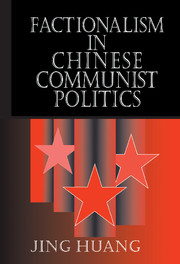Book contents
- Frontmatter
- Contents
- List of Figures and Tables
- Preface
- List of Abbreviations
- Introduction
- 1 Factionalism, the Puzzle of Chinese Communist Politics
- 2 Factionalism and the Political System in China
- 3 The Establishment of the Yan'an Round Table
- 4 The Transition of the Yan'an Round Table
- 5 Crises in Leadership Relations with the Two-Front Arrangement
- 6 The Collapse of the Yan'an Round Table and the Unleashing of Factionalism
- 7 Deng Xiaoping's Dominance: Factionalism Prevails over the Party Spirit
- 8 Conclusion
- Selected Bibliography
- Index
4 - The Transition of the Yan'an Round Table
Published online by Cambridge University Press: 11 September 2009
- Frontmatter
- Contents
- List of Figures and Tables
- Preface
- List of Abbreviations
- Introduction
- 1 Factionalism, the Puzzle of Chinese Communist Politics
- 2 Factionalism and the Political System in China
- 3 The Establishment of the Yan'an Round Table
- 4 The Transition of the Yan'an Round Table
- 5 Crises in Leadership Relations with the Two-Front Arrangement
- 6 The Collapse of the Yan'an Round Table and the Unleashing of Factionalism
- 7 Deng Xiaoping's Dominance: Factionalism Prevails over the Party Spirit
- 8 Conclusion
- Selected Bibliography
- Index
Summary
The centralization started in August 1952: the Northeastern People's Government was downgraded into an administrative council, and the Civil and Military Commissions in the other five regions followed three months later. All the regional leaders were moved to Beijing in 1952–3: Gao Gang from the Northeast; Peng Dehuai and Xi Zhongxun from the Northwest; Rao Shushi from the East; Lin Biao, Deng Zihui, and Ye Jianying from the Central-South; and Deng Xiaoping and He Long from the Southwest. This resulted in an overall redistribution of power, which in turn provoked a fierce power struggle among the Yan'an Round Table members: the Gao-Rao Affair.
Although opinions vary on this event, the CCP official account and the Western analysis appear consistent in their explanations – that a power-hungry Gao Gang “misinterpreted” Mao's intention and “miscalculated” the situation, and that Gao and Rao were purged because their activities jeopardized the Party's unity. Although Teiwes highlighted factionalism in his analysis, its implications are mostly seen in Gao's “search of allies”. But my examination of this event suggests:
A power struggle emerged during the centralization that involved a redistribution of power in the Party system. Given the faction-ridden structure of leadership relations, this struggle evolved into a clash between the two major mountaintops, led by Liu Shaoqi and Gao Gang respectively, in the Party.
[…]
- Type
- Chapter
- Information
- Factionalism in Chinese Communist Politics , pp. 159 - 210Publisher: Cambridge University PressPrint publication year: 2000



